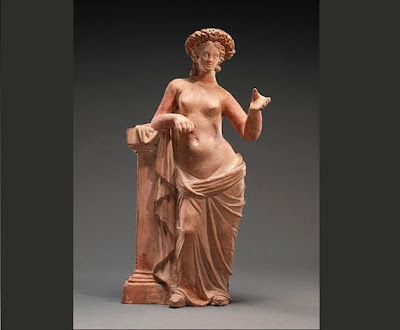ARCHAEOLOGY
The Alphabet
The foundation of spoken language, the alphabet, is a human communication method (a set of letters in a static order used to represent the rudimentary set of speech sounds).
Hieroglyphs line the walls in a shrine to the goddess Hathor at Serabit el-Khadim. Credit: Courtesy Lydia Wilson
“Who Invented the Alphabet?
New scholarship points to a paradox of historic scope: Our writing system was devised by people who couldn’t read
Centuries before Moses wandered in the “great and terrible wilderness” of the Sinai Peninsula, this triangle of desert wedged between Africa and Asia attracted speculators, drawn by rich mineral deposits hidden in the rocks. And it was on one of these expeditions, around 4,000 years ago, that some mysterious person or group took a bold step that, in retrospect, was truly revolutionary. Scratched on the wall of a mine is the very first attempt at something we use every day: the alphabet.”The sphinx discovered at Serabit is sometimes referred to as “the Rosetta Stone of the alphabet. Credit: British Museum
"This is a direct citation" By Lydia Wilson SMITHSONIAN MAGAZINE, JANUARY/FEBRUARY 2021. Read the full story, retrieved from https://www.smithsonianmag.com/history/inventing-alphabet-180976520
Sacred Area – Neolithic period
“Archaeologists in Turkey Unearth 2,500-Year-Old Temple of Aphrodite
Aphrodite, portrayed in different ways over the centuries, had many worshippers in the sixth century B.C. Credit: J. Paul Getty Museum via Wikimedia Commons
An inscription found at the site—dedicated to the Greek goddess of love and beauty—states, “This is the sacred area.”
Evidence of human settlement on the Urla-Çeşme peninsula, where the temple was found, dates back to the late Neolithic period.”
"This is a direct citation" By Livia Gershon. Read the full story, retrieved from https://www.smithsonianmag.com/smart-news/2500-year-old-temple-aphrodite-found-turkey-180976694
NATURAL HISTORY
Currently, in focus, The Platypus has baffled science with its extraordinary diversity and bizarre characteristics.
Credit: Oceanservice.noaa.gov
“How Earth’s Oddest Mammal Got to be so Bizarre
Often considered the world’s oddest mammal, Australia’s beaver-like, duck-billed platypus exhibits an array of bizarre characteristics: it lays eggs instead of giving birth to live babies, sweats milk, has venomous spurs and is even equipped with 10 sex chromosomes.
Now, an international team of researchers led by the University of Copenhagen has conducted a unique mapping of the platypus genome and found answers regarding the origins of a few of its stranger features.” FACULTY OF SCIENCE – UNIVERSITY OF COPENHAGEN
https://www.heritagedaily.com/2021/01/how-earths-oddest-mammal-got-to-be-so-bizarre
LIVE SCIENCE
Even time did not escape 2020 unscathed.
The 28 fastest days on record (since 1960) all occurred in 2020, with Earth completing its revolutions around its axis milliseconds quicker than average.”
"This is a direct citation." Originally published on Live Science, Stephanie Pappas - Live Science Contributor. Read the full story, retrieved from https://www.livescience.com/earth-spinning-faster-negative-leap-
LIFE’S LITTLE MYSTERIES
"Why was Stonehenge built?
Stonehenge is perhaps the most famous of all the henges, vast circular monuments constructed from wood or stone that litter the British countryside. The prehistoric monument was most likely erected in what is now England sometime between 3000 B.C. and 2000 B.C., and some of the stones were transported all the way from neighboring Wales — no small feat for a Stone Age civilization.”
"This is a direct citation." Originally published on Live Science, by Benjamin Plackett - Live Science Contributor. Read the full story, retrieved from https://www.livescience.com/why-were-henges-built.html
“Stonehenge: Facts & Theories About Mysterious Monument."
View more. Live Science, by Owen Jarus - Live Science Contributor, August 19, 2017. Read the full story, retrieved from https://www.livescience.com/22427-stonehenge-facts.html
Stonehenge is perhaps the most famous of all the henges, vast circular monuments constructed from wood or stone that litter the British countryside. The prehistoric monument was most likely erected in what is now England sometime between 3000 B.C. and 2000 B.C., and some of the stones were transported all the way from neighboring Wales — no small feat for a Stone Age civilization.”
"This is a direct citation." Originally published on Live Science, by Benjamin Plackett - Live Science Contributor. Read the full story, retrieved from https://www.livescience.com/why-were-henges-built.html
“Stonehenge: Facts & Theories About Mysterious Monument."
View more. Live Science, by Owen Jarus - Live Science Contributor, August 19, 2017. Read the full story, retrieved from https://www.livescience.com/22427-stonehenge-facts.html
The stones of Stonehenge have endured centuries of weathering and erosion. Credit: ivanovsky Shutterstock









No comments:
Post a Comment